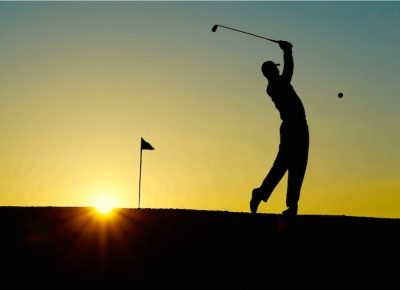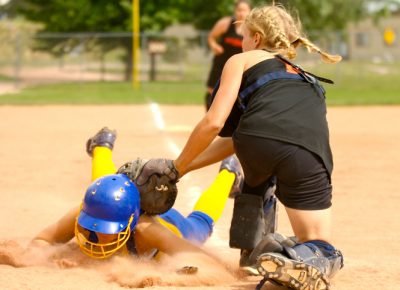Monthly Archives: August 2019
A Golfer’s Guide to Preventing Injury on the Green

With golf season in full swing, so is the potential for injury. Although golf is considered a low-intensity sport that almost anyone can play, there are still risks involved. Contrary to popular belief, golfers are prone to experiencing injury more-so than even some of the roughest and toughest athletes out there. In fact, one study by the National Health Statistics Reports found that injuries in recreational sports such as golf occur more frequently than those in team sports like rugby and hockey at a rate of 1.8/1000 versus 1.5/1000!
With the warmth and summer sunshine upon us, everyone is grabbing their clubs and hitting the links. However, many are not taking the proper steps to prevent some of the most common ailments known to golfers such as injuries to the elbow, shoulder, hip and back. So, what can golfers do to prevent complications as they get back into the swing of things? Here are a few suggestions:
- Technique: The basis of a strong golf game is proper swing. Poor swing can put abnormal stress on the muscles in the arms, shoulders, back and hips. Over the course of a round or multiple rounds, this can lead to sprains, strains and overuse injuries like tendinitis. Correcting your form and being aware of it as you go along will help prevent these types of injuries.
- Training: Even with the best technique, your body needs to be able to handle the rigors of a round of golf. Training your muscles to perform for 18 holes is essential for keeping up – and staying healthy. For this reason, undergoing professional evaluation with tools such as the Titleist Performance Institute’s Functional Movement Screen can identify weaknesses and help develop an individualized training regimen.
- Warming Up: Studies have shown that the average golfer spends less than 10 minutes warming up, not nearly enough time to get both mentally and physically prepared for a round of golf. Getting to the course early enough allows for ample amount of time to complete a proper warmup routine, which should include light stretching to loosen up the body and time to work through your entire bag of clubs, from putter to driver. While working through the bag, envision different scenarios you might face during the round and your mind will be warmed up just as much as your body!
- Back to Basics: Not all golf injuries are musculoskeletal in nature. Be prepared for the environment you will be playing in! Dress appropriately for the weather to avoid overheating, apply plenty of sunscreen to reduce the risk of sunburn, and be sure to drink plenty of fluids in hot weather.
Following these simple tips may help prevent some of the most common injuries golfers suffer from. However, if you do experience persistent pain, don’t wait. Making an appointment with a sports medicine specialist to get an accurate diagnosis and treatment plan can help prevent chronic injury and get you back on the green faster than you might expect.
Dr. Brian Sokalsky is the physician at the helm of Jersey Shore Sports Medicine in Somers Point and Lanoka Harbor, New Jersey. Dr. Brian is a board-certified family physician with special training in sports medicine and utilizes treatment options at the forefront of non-surgical healing, as well as holistic approaches, to treat his patients. Whether treating a star athlete who was injured on the field, getting a weekend warrior back into the game, or counseling a patient on medical weight loss, Dr. Brian is known to take the thoughtful, disciplined and customized approach that makes the difference. Serving as an active member of the community, Dr. Brian provides game coverage to local high school sports teams and club rugby teams. To find out more or to schedule an appointment, call (609) 904-2565 or visit jerseyshoresportsmedicine.com.
Golfer’s Elbow and Tennis Elbow – Preventing Chronic Pain

Chronic and uncomfortable elbow pain is one of the most frequent ailments that golfers face and, as many of you may know, is referred to as golfer’s elbow and tennis elbow. Golfer’s elbow is the commonly used term for medial epicondylitis, which is excessive inflammation of the common flexor tendon. This flexor tendon attaches the muscles that flex the wrist and fingers to the medial epicondyle of the humerus. In addition to golfer’s elbow, lateral epicondylitis – or tennis elbow – can develop on the other side of the elbow and can cause serious chronic pain.
Golfer’s elbow and tennis elbow are very similar injuries. The difference between them come from which tendon is affected and where the pain resides. For golfer’s elbow, pain is felt in the flexor tendon on the pinky side of the elbow. For tennis elbow, pain is felt in the extensor tendon, which causes pain on the thumb side of the elbow.
Both injuries occur due to acute damage that does not heal properly, from chronic overuse, or a combination of both. The resulting symptoms include tenderness to touch and pain with movements such as gripping (shaking hands), twisting (opening a jar) and lifting objects (sometimes as light as a coffee mug!). This type of pain is also known to radiate down the forearm to the wrist, which can cause further issues. Additionally, the elbow may experience painful swelling.
The primary treatment for these injuries is the most hated word in all of sports, REST. Both injuries stem from the tendon not properly healing, often due to overuse. Therefore, rest provides the injured structures time to heal properly and fully. Treatments that can speed the recovery process are cortisone injections, oral anti-inflammatory medications such as ibuprofen or naproxen, and physical therapy. Chronic cases that fail initial treatments respond well to regenerative treatments such as prolotherapy and platelet rich plasma injections, which do not require surgery. Finally, there are often underlying issues with swing technique that need to be corrected to prevent recurrence of the injury, which can be addressed with a professional TPI screen.
Ultimately, rest is required to allow the tendons sufficient time to heal. However, medications, physical therapy, and injections can help speed recovery. Regenerative treatments can also provide a more rapid return to the links versus surgery. And as with most other sports injuries, correcting flaws in technique can help prevent pain from coming back.
Dr. Brian Sokalsky is the physician at the helm of Jersey Shore Sports Medicine in Somers Point and Lanoka Harbor, New Jersey. Dr. Brian is a board-certified family physician with special training in sports medicine and utilizes treatment options at the forefront of non-surgical healing, as well as holistic approaches, to treat his patients. Whether treating a star athlete who was injured on the field, getting a weekend warrior back into the game, or counseling a patient on medical weight loss, Dr. Brian is known to take the thoughtful, disciplined and customized approach that makes the difference. Serving as an active member of the community, Dr. Brian provides game coverage to local high school sports teams and club rugby teams. To find out more or to schedule an appointment, call (609) 904-2565 or visit jerseyshoresportsmedicine.com.
Baseball and Softball – Keep Your Budding Athlete Healthy

Baseball and softball put a unique set of stresses on an athlete’s body, especially young athletes that are still growing. As a result, injuries to the shoulder and elbow are very common. As we look forward to warmer weather and the start of the season, now is a great time to discuss proper training and conditioning to put our budding athletes in the best position to stay healthy!
Off-season: In the offseason, it is common for athletes to wait until the spring to begin preparing for their season. However, this can significantly increase the risk of injury. It is more effective to gradually strengthen and condition the body, especially the arms and core, rather than attempt to cram preseason training into a short period of time. December-February, typically considered the offseason, is actually the best time to begin training. A training program should focus on the following three areas to train the entire body:
- Stretching and flexibility exercises (Daily)
- Speed and agility exercises (2-3 times per week)
- Strengthening exercises (3-4 time per week)
Pre-season: Once preseason training is underway, the ultimate goal is to fully prepare the body and arm for the daily practices and competitions ahead. Gradual increases in duration and intensity of throwing should be followed during this time. A daily warm-up and flexibility routine for the whole body, with additional focus on the arm and shoulder girdle, should be instituted. Alternating between the upper body, shoulder girdle and arm, and core and lower body will ensure that the entire body receives proper conditioning. These workouts should not be done before or after games or heavy practices.
In-season: Once the season has arrived, the main focus is to avoid injury and manage the daily aches and pains that are unique to baseball and softball players. The daily warm-up and stretching routine should be continued, with additional stretching and ice treatments after practices and games. (See our ‘Hot Treatment Vs. Cold Treatment’ Blog Post for proper icing instructions). Pitch counts are also very important to follow in all age groups up through high school, for both baseball and softball. Close attention must be paid to players competing on multiple teams whose seasons overlap as overuse injuries are more common for those playing on multiple teams. For more information about pitch counts, visit the American Sports Medicine Institute’s website and check out these Softball Injury Prevention guidelines.
Post-season: The trend over the last decade in many sports is for athletes, particularly kids, to specialize in one sport and play it year-round. However, studies have shown that sport specialization dramatically increases the risk of overuse injuries. With this being said, all throwing athletes should take at least 2-3 months off from throwing every year. During this time, it is suggested to transition back into the offseason conditioning program. Here at Jersey Shore Sports Medicine, we suggest that athletes, especially our younger players, be encouraged to participate in other sports in order to develop a more well-rounded set of abilities and reduce the risk of overuse injuries.
If you would like more information about our sports medicine services or have questions about training, please call our office at 609-904-2565 to make an appointment. As always, feel free to join the conversation with us on our Facebook and Twitter pages!
